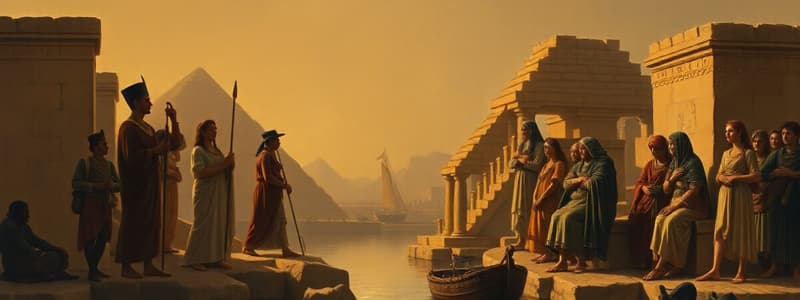Podcast
Questions and Answers
Who conquered Egypt in 526 BC?
Who conquered Egypt in 526 BC?
- Alexander the Great
- The Romans
- Ptolemy III
- Cambyses, the Persian king (correct)
How is 'Kocesezen' translated from Greek?
How is 'Kocesezen' translated from Greek?
Two rivers
What makes someone from the outside, join the ranks of slaves?
What makes someone from the outside, join the ranks of slaves?
War
What are the three classes of the Egyptian society?
What are the three classes of the Egyptian society?
What happened in 332 BC to Egypt?
What happened in 332 BC to Egypt?
According to archaeological digs, what was made from ______?
According to archaeological digs, what was made from ______?
Flashcards
East-West Dichotomy
East-West Dichotomy
A paradigm contrasting European and non-European societies, highlighting perceived differences in values, freedom, and social structures.
Nile's Role in Egypt
Nile's Role in Egypt
Development in part occurred due to the Nile River's reliable flooding providing water and stimulating community building.
Power Structure
Power Structure
The rulers of Egypt and temple accountants held significant power, alongside landowners and the community.
Origin of Slavery
Origin of Slavery
Signup and view all the flashcards
Persian Conquest (526 B.C.)
Persian Conquest (526 B.C.)
Signup and view all the flashcards
Alexander's Egypt (332 B.C.)
Alexander's Egypt (332 B.C.)
Signup and view all the flashcards
Mesopotamia Definition
Mesopotamia Definition
Signup and view all the flashcards
Eastern Despotism
Eastern Despotism
Signup and view all the flashcards
Pergaun's Role
Pergaun's Role
Signup and view all the flashcards
Collapse of Sixth Dynasty Factors
Collapse of Sixth Dynasty Factors
Signup and view all the flashcards
Local Dissatisfaction
Local Dissatisfaction
Signup and view all the flashcards
XI Dynasty Agriculture
XI Dynasty Agriculture
Signup and view all the flashcards
Wars for Labor
Wars for Labor
Signup and view all the flashcards
Consolidation Centers
Consolidation Centers
Signup and view all the flashcards
Weak State Vulnerability
Weak State Vulnerability
Signup and view all the flashcards
Assyrian King
Assyrian King
Signup and view all the flashcards
Formation of States
Formation of States
Signup and view all the flashcards
United Egypt
United Egypt
Signup and view all the flashcards
Pharaoh's Growing Power
Pharaoh's Growing Power
Signup and view all the flashcards
Middle Kingdom Beginning
Middle Kingdom Beginning
Signup and view all the flashcards
Hyksos Invasion
Hyksos Invasion
Signup and view all the flashcards
Expansion to Syria
Expansion to Syria
Signup and view all the flashcards
Akhenaten's Wisdom
Akhenaten's Wisdom
Signup and view all the flashcards
Battle Against Hittites (1280 BC)
Battle Against Hittites (1280 BC)
Signup and view all the flashcards
Recognizing Differences
Recognizing Differences
Signup and view all the flashcards
Ethics Intoduction
Ethics Intoduction
Signup and view all the flashcards
Land Mastery
Land Mastery
Signup and view all the flashcards
Tribal Origins
Tribal Origins
Signup and view all the flashcards
Sea peoples
Sea peoples
Signup and view all the flashcards
Tax Collection
Tax Collection
Signup and view all the flashcards
Study Notes
- European differences started to become apparent in the world
- Greeks noticed differences between Egyptians and Persians
- Greeks laid the foundation for science by analyzing eastern societies
- Social and economic development in Ancient Egypt linked to Nile River location
- Life sustainability and the possibility of creating irrigation systems came with Nile location
- Tribes formed and ethnic groups mixed in stages around 4000 BC
- Land was irrigated with hoes, skilled artisans made axes, dishes, and containers in the second half of the 4th millennium
- Ornaments were sometimes made of copper/meteorite iron
- Three main social layers existed: rulers, tax collectors, and community members/farmers
- People who were in debt gradually became slaves
- Slaves became useful after conflicts
- Captive-slaves increased the community’s membership
Studying That Suits You
Use AI to generate personalized quizzes and flashcards to suit your learning preferences.
Description
Explore social and economic development in Ancient Egypt. Learn about the influence of the Nile River, the formation of tribes, and the emergence of social classes. Understand the role of irrigation, craftsmanship, and the use of slaves in ancient Egyptian society.




